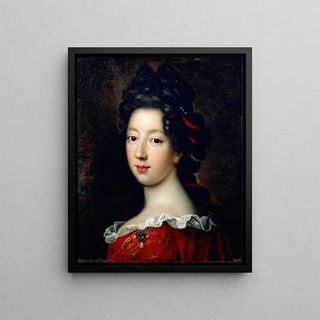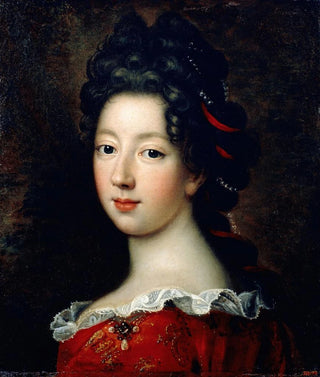Art print | Louise Françoise de Bourbon Mademoiselle de Nantes - Jean-François de Troy


View from behind

Frame (optional)
In the vast panorama of art history, some works stand out for their ability to capture the essence of an era, to immortalize iconic figures, and to evoke deep emotions. The representation of Louise Françoise de Bourbon, Mademoiselle de Nantes, by Jean-François de Troy, is a compelling example of this artistic alchemy. Created in the early 18th century, this piece is much more than a simple portrait; it is an open window into the court of Versailles, a visual testament to French nobility and the intrigues that took place there. Through this art print, viewers are invited to immerse themselves in a world of refinement and sophistication, where every detail tells a story.
Style and uniqueness of the work
Jean-François de Troy's style is characterized by remarkable finesse and meticulous attention to detail. In the portrait of Louise Françoise, the artist manages to capture not only her physical beauty but also her character and status. The composition is carefully orchestrated, with a subtle play of light and shadow that highlights the delicate features of the young woman. The sumptuous clothing, adorned with embroidery and refined motifs, testifies to the richness and elegance of her rank. Troy uses a soft color palette, blending pastel tones with more vivid shades, creating a visual harmony that delights the eye. This portrait also stands out for its intimate atmosphere, where one feels an almost personal connection between Louise Françoise and the viewer, as if she were about to share a secret.
The artist and his influence
Jean-François de Troy, born in 1679, was a French painter whose work is rooted in the portraiture tradition of the Grand Siècle. A student of Charles Le Brun, he developed a style that combines academic rigor with personal sensitivity. Through his works, he contributed to establishing the portrait as a major artistic genre, distinguished by his ability to humanize his subjects while respecting noble conventions. Troy had a notable influence on his contemporaries and left a lasting legacy

Matte finish

View from behind

Frame (optional)
In the vast panorama of art history, some works stand out for their ability to capture the essence of an era, to immortalize iconic figures, and to evoke deep emotions. The representation of Louise Françoise de Bourbon, Mademoiselle de Nantes, by Jean-François de Troy, is a compelling example of this artistic alchemy. Created in the early 18th century, this piece is much more than a simple portrait; it is an open window into the court of Versailles, a visual testament to French nobility and the intrigues that took place there. Through this art print, viewers are invited to immerse themselves in a world of refinement and sophistication, where every detail tells a story.
Style and uniqueness of the work
Jean-François de Troy's style is characterized by remarkable finesse and meticulous attention to detail. In the portrait of Louise Françoise, the artist manages to capture not only her physical beauty but also her character and status. The composition is carefully orchestrated, with a subtle play of light and shadow that highlights the delicate features of the young woman. The sumptuous clothing, adorned with embroidery and refined motifs, testifies to the richness and elegance of her rank. Troy uses a soft color palette, blending pastel tones with more vivid shades, creating a visual harmony that delights the eye. This portrait also stands out for its intimate atmosphere, where one feels an almost personal connection between Louise Françoise and the viewer, as if she were about to share a secret.
The artist and his influence
Jean-François de Troy, born in 1679, was a French painter whose work is rooted in the portraiture tradition of the Grand Siècle. A student of Charles Le Brun, he developed a style that combines academic rigor with personal sensitivity. Through his works, he contributed to establishing the portrait as a major artistic genre, distinguished by his ability to humanize his subjects while respecting noble conventions. Troy had a notable influence on his contemporaries and left a lasting legacy






